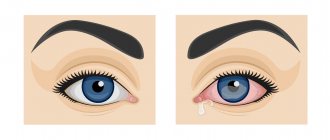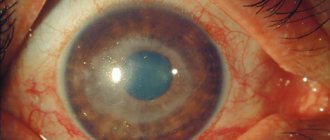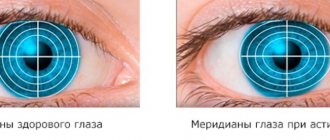To look, to see - for a healthy person this is natural, normal, familiar, obvious. Pay attention to the last synonym: it is “OBVIOUSLY”, i.e. Even in language and collective consciousness, the visual process is fixed as something self-evident and does not require explanation. Before high school, it was very rare for a child to be able to clearly explain how and why he sees; at best, the answer will be something like this: “We just open our eyes and look.” However, how many adults are able to answer in more detail?
Healthy eyes serve us faithfully, without attracting attention to themselves. They serve as long as they are able to serve. Despite our long hours, day after day and year after year, sitting at the computer, our habit of reading in shaking vehicles, at lunch or in the “cozy” twilight (while taking bizarre poses on the sofa or in an armchair); serve, despite smoking and alcohol, continuous staring at screens and small screens, physical and mental overload, hypovitaminosis and unnatural food in almost lethal doses; serve, despite the habit of rubbing them with your hands, where the entire periodic table, all known and not yet discovered viruses, bacteria and fungi, have accumulated over the course of a day...
The eyes try to serve us to the last, despite all our man-made allergies, injuries, ultraviolet burns, the sandy-acid air of megacities and the dead water of swimming pools, into which we plunge with the blissful goal of improving our health. “Despite...”, “We’ll see,” “We’ll see,” we say, and, of course, we don’t think about our own organs of vision until problems begin.
And this is where we become major specialists. We suddenly begin to understand how complex and vulnerable this optical-neuromechanical system is – our eye. An invaluable gift that was created over millions of years of organic evolution, but sometimes is destroyed in a matter of months or weeks due to our own, excuse me, stupidity, carelessness and ignorance. That’s how we are designed: what we have, we don’t keep, but having lost it... unfortunately, it’s often too late to cry, since many diseases, lesions and pathological processes of the eyes are irreversible. And perhaps those who have partially or completely lost it could tell the best story about vision. This is how man is made. How do eye diseases work? How and why do they arise? Can they be avoided? How to treat them?
Myopia (nearsightedness)
Myopia in children is one of the most common eye diseases. With myopia, a person sees objects that are close up well and objects that are far away poorly. Signs of myopia are obvious: the child squints when he needs to see something at a distant distance, when watching TV he tries to sit closer, when reading he brings a book close to his eyes. Due to constant tension, headaches may begin and fatigue may occur. Most often, myopia is diagnosed at the age of 9-12 years. During adolescence it may intensify. If myopia is detected, the ophthalmologist prescribes vision correction - glasses or lenses. Drug treatment may be prescribed - eye drops, strengthening vitamins. It is advisable to do eye exercises. High myopia may require surgery.
Eye diseases in children
Ophthalmological pathology in children can be either congenital: glaucoma, cataracts, malformations (coloboma of the eyelids, iris, lens, retina; aniridia; microphakia; microphthalmia, etc.) or acquired (infectious diseases, injuries, refractive errors).
Features of eye diseases in children:
- A child often cannot complain about decreased vision, which leads to untimely consultation with a doctor.
- Even a slight decrease in vision in childhood can lead to serious problems in the future (a weak degree of myopia or farsightedness causes the development of strabismus and amblyopia).
- Inability to use a number of treatment methods or medications (eye drops and ointments, contact and laser correction)
- Difficulties in diagnosis (the child cannot undergo studies that require a response from the patient: perimetry, visometry, etc.)
The main diagnoses given to children are:
- Infectious diseases (conjunctivitis, blepharitis, etc.)
- Congenital defects (cataracts, glaucoma, eyelid ptosis, etc.)
- Refractive errors (myopia, hypermetropia, astigmatism)
- Oculomotor pathology (strabismus, nystagmus) and amblyopia
Hypermetropia (farsightedness)
With this disease, the child has difficulty seeing nearby objects. However, objects at a distance are also not very clearly visible. It all depends on the degree of hypermetropia. A child, experiencing such discomfort, unconsciously tries to move away from the object or move it away in order to see it better. Symptoms of farsightedness can also include headaches, fatigue, and nausea, which are a consequence of regular strain on the visual system. Treatment is similar to myopia - vision-correcting lenses or glasses, eye exercises, surgery.
Inflammatory (infectious and allergic)
A huge group is formed by inflammatory processes , and almost any element of the visual system can become inflamed: eyelids (blepharitis), mucous membrane (conjunctivitis), cornea (keratitis), etc. The main pathogenic factors in this case are infections (viral, bacterial, protozoal, fungal); allergic reactions; mechanical, chemical or physical irritations; as well as ametropia to a pronounced degree, since they cause constant eye strain.
Conjunctivitis
Conjunctivitis is an inflammation of the mucous membrane of the eye, which can be caused by an allergy, bacterial or viral infection. Often this disease is accompanied by blepharitis and keratitis. Signs:
- Swelling of the eyelids;
- Clear or purulent discharge;
- Itching, burning;
- Dilatation of blood vessels in the eyes.
Depending on the etiology of the disease, antiviral or antibacterial agents are prescribed: gels, ointments, drops. If the disease is caused by an allergy, then antihistamines are also included in the treatment.
Eye diseases and symptoms
Amblyopia
Amblyopia is a functional vision disorder that cannot be treated with glasses or contact lenses. With this disease, vision deterioration occurs irrevocably: contrast perception and accommodation capabilities are impaired. Amblyopia can occur in one eye or both at the same time. It is characterized by the following symptoms:
- vision in one or both eyes decreases;
- difficulties arise with visualizing three-dimensional objects;
- problems arise in measuring visual distance to objects;
- the process of receiving visual information deteriorates.
Amblyopia most often develops in childhood. This disease is otherwise called “lazy eye”. Due to a number of eye diseases (astigmatism, myopia, cataracts, corneal opacity, etc.), vision is reduced in one eye, and the brain turns it off from the vision process, perceiving information from only one eye. It is important to notice this situation in time and begin treatment, otherwise it will be impossible to restore vision to the eye in adulthood.
Astigmatism
With astigmatism, due to the irregular shape of the cornea of the eye (normally it has a spherical shape, and in the case of astigmatism, it is shaped like a melon or a rugby ball), the refraction of light rays occurs incorrectly (instead of one, two foci are formed), and the perception of the surrounding world is disrupted. With corneal astigmatism, vision problems arise due to the abnormal structure of the cornea. With lens-type (lenticular) astigmatism, vision deteriorates due to changes in the lens.
Astigmatism is characterized by the following symptoms:
- “blurry” visualization of objects (uneven edges, unclear contours);
- feeling of double vision;
- the need to constantly strain your eyes to focus on the subject;
- headaches arising from constant overstrain of the visual apparatus;
- frequent squinting.
In childhood, astigmatism can lead to amblyopia (“lazy eye”) and requires treatment with optical and hardware methods. In adults (after 18 years of age), it is possible to correct astigmatism using laser vision correction.
Blepharitis
Blepharitis is a lesion of the eyelids that occurs due to the development of inflammation. There are several types of the disease. The most common diagnosis is chronic blepharitis, which is difficult to treat with medications. Blepharitis may be associated with other diseases of the visual system, such as ocular tuberculosis and conjunctivitis. It is often accompanied by purulent lesions of the eyelids and loss of eyelashes.
Treatment is carried out by taking antibiotics. Before a course of therapy, serious diagnostics are carried out to identify the root causes of the disease.
Main symptoms of blepharitis:
- feeling of swelling on the eyelids;
- severe itching;
- eyelash loss;
- feeling of dry skin around the eyes;
- burning and feeling of “sand” in the eyes;
- peeling of the skin on the eyelids;
- the appearance of ulcers and crusts;
- decreased vision;
- photophobia.
Myopia (nearsightedness)
Myopia is a disease characterized by impaired refraction of the eyes. The patient is unable to see in detail objects located at a great distance from him. The cause of visual impairment is improper fixation of rays on the retina. They lie not on the retina itself, but in front of it. Because of this, the picture is blurred. Pathological refraction of rays in the visual system is manifested by the following symptoms:
- inability to clearly see objects located at a distance;
- frequent pain in the temples and forehead;
- burning sensation in the eyes.
Myopia is corrected with glasses or contact lenses, and if the patient does not want to wear them, surgery is performed using an excimer laser.
Glaucoma
Glaucoma is a chronic disease of the visual system. The reason is increased intraocular pressure. It leads to dysfunction of the optic nerves and their damage. The optic nerves are not restored - the process of vision loss in this case is irreversible. There are two forms of glaucoma:
- open angle;
- closed angle.
The consequences of glaucoma depend on the nature of its course and the individual characteristics of the human visual system. Acute glaucoma can cause permanent loss of vision. Treatment is carried out by an ophthalmologist together with a neurologist.
With glaucoma, the patient experiences the following dysfunctions:
- dark objects appear before your eyes;
- lateral vision deteriorates;
- decreased ability to see in the dark;
- image clarity decreases;
- “rainbow” shimmers appear when looking at lamps, the sun and other light sources.
Despite the listed signs, glaucoma is a very insidious disease that does not manifest itself in any way in the initial stages of development. Therefore, it is necessary, especially after 40 years, to visit an ophthalmologist at least once a year. Today there are many ways to reduce eye pressure and treat glaucoma: medication, laser and surgical treatment.
Farsightedness (hypermetropia)
Farsightedness is a disease associated with refractive error in the visual system. Light rays are focused not on the retina, as should normally happen, but behind it. With farsightedness, a person has difficulty distinguishing between objects located both at a close distance and at a distance from it.
Farsightedness can be manifested by the following symptoms:
- asthenopia;
- strabismus;
- poor fixation during binocular vision;
- increased eye fatigue;
- regular headaches;
- feeling of fog before the eyes.
At a young age, patients may not notice farsightedness, because the lens of the eye is still elastic and is able to change its shape, adjusting to work both near and far, thereby compensating for farsightedness. And with age, this problem will worsen vision.
Cataract
Cataracts occur due to complete or partial clouding of the lens of the eye. It can affect one visual organ or both at the same time. The essence of the disease is that due to clouding of the lens, light rays cannot enter the eye, onto the retina. As a result, visual acuity decreases. In some cases, advanced cataracts lead to complete loss of vision.
Most often the disease occurs in older people. In young patients, the development of cataracts may be associated with previous somatic diseases or eye injuries. Medicine knows cases of congenital cataracts.
Main symptoms of cataracts:
- blurred vision;
- the emergence of a regular need to replace glasses;
- decreased vision at night;
- increased eye sensitivity to bright light;
- decreased ability to distinguish colors;
- sensation of a veil before the eyes, as if looking through foggy glass;
- halos around light sources;
- pain in the eyes when reading.
In some cases, cataracts can cause double vision in one eye when the other eye is closed.
Keratoconus
Keratoconus is a degenerative disease of the cornea. Normally its shape is spherical. As the cornea becomes thinner, it protrudes forward and takes the shape of a cone. This disease often occurs at a young age and leads to changes in optical properties. At the initial stage of the disease, it is possible to correct visual functions with the help of glasses, but the further the disease progresses, the more often it is necessary to select new glasses.
Keratoconus is characterized by the following symptoms:
- a sharp decrease in vision in one eye;
- reducing the clarity of the contours of objects;
- the appearance of halos around light sources when looking at them;
- increased eye fatigue;
- rapid development of myopia.
With keratoconus, the patient needs to regularly replace glasses with enhanced lenses. Vision deterioration can be stopped if you consult an ophthalmologist in time. Eye surgeons use several types of operations, primarily aimed at stopping the progression of keratoconus. At advanced stages, keratoplasty is performed - operations to replace the cornea of the eye with a donor one.
Keratitis
With keratitis, inflammation of the cornea of the eyeball develops and a feeling of cloudiness in the eyes occurs. The most common cause of keratitis is a viral infection. The disease can also develop as a result of eye injury. Damage to the cornea can spread to other areas of the visual system over time.
Keratitis occurs in several forms:
- light;
- moderate;
- heavy.
Based on the causes of occurrence, this disease is divided into:
- to exogenous - inflammation began due to exposure to external factors;
- endogenous - inflammation arose due to internal changes in the human body.
Keratitis is characterized by the following symptoms:
- photophobia;
- profuse lacrimation;
- redness of the eyelid and eyeball;
- blepharospasm (convulsive compression of the eyelid);
- loss of natural shine of the cornea;
- sensation of a foreign body in the eye.
Computer vision syndrome
Working at a computer for a long time can lead to the development of computer vision syndrome. This is the name for a set of pathologies of the visual system associated with eye strain in front of the monitor. To one degree or another, the syndrome manifests itself in 60% of personal computer users. It develops due to the specifics of the image on the monitor, incorrect ergonomics of the workspace and non-compliance with the correct mode of working at the computer.
The main symptoms of computer vision syndrome:
- decreased visual acuity;
- increased eye fatigue;
- tearfulness;
- photophobia;
- burning in the eyes;
- difficulty focusing on objects located near or far away;
- split image;
- dry eyes;
- redness and pain in the eyes.
The main problem when working at a computer is that the eyes are under constant tension and the person blinks very rarely - dryness occurs. Therefore, the recommendations of ophthalmologists are as follows: take breaks from work and use moisturizing drops.
Conjunctivitis
Conjunctivitis is an inflammation of the mucous membrane (conjunctiva) that covers the outer surface of the eyeballs and the adjacent surface of the eyelids. The disease can be of a different nature: viral, bacterial, allergic, chlamydial or fungal. Some types of conjunctivitis are contagious and can be transmitted from one person to another in everyday life. Infectious conjunctivitis is not a strong threat to the visual system, but in some cases it can cause serious complications.
Symptoms of conjunctivitis vary depending on the nature of the disease. Most often there are:
- swelling and redness of the eyelids;
- discharge of mucous and pus;
- increased tearfulness;
- burning sensation and itching.
Macular degeneration
The macula is the area that is located in the center of the retina of the eye. Small in size, it is responsible for image clarity and correct color perception. With macular degeneration (chronic pathology of the macula), visual functions decrease. The disease can occur in two forms: wet and dry. Both lead to vision impairment, but the wet form is considered more dangerous, as it is fraught with complete loss of central vision.
The main symptoms of macular degeneration:
- the appearance of a cloudy spot in the center of the visual field;
- loss of reading ability;
- deformation of lines and contours of the image.
Floaters in the eyes
Destruction of the vitreous body is a condition in which the patient experiences “floaters” in the eyes. The cause of visual impairment lies in local changes in the structure of the vitreous body, leading to the appearance of optically opaque particles. It is these particles that are perceived by the eye as floating “flies”. Destruction of the vitreous body does not pose a serious threat to vision, but causes some discomfort.
Symptoms of destruction usually appear in strong lighting. Along with “floaters”, small spots, threads or dots may appear that move within the boundaries of a person’s field of vision.
Retinal disinsertion
Retinal detachment is one of the most dangerous pathologies of the visual system. In the absence of timely surgical intervention, the disease can lead to complete loss of vision. Detachment of the retina from the deep pigment epithelial tissues of the choroid occurs for various reasons.
The main symptoms of retinal detachment:
- frequent appearance of glare and sparks before the eyes;
- the appearance of a veil that obscures the field of vision;
- reduction of image sharpness;
- deformation of the contours and appearance of objects visible to the eye.
To avoid this pathology, it is important to visit an ophthalmologist at least once a year to examine the fundus. If micro-tears or dystrophies are detected, such areas are attached to other membranes of the eye using a laser, thereby preventing ruptures and detachment.
Ophthalmic rosacea
Ophthalmic rosacea (rosacea) is a dermatological disease closely related to ophthalmology. It manifests itself as irritation and dry eyes, blurred vision. The image becomes blurry and blurry. The culmination of the disease is severe inflammation of the surface of the eyes. Ophthalmic rosacea can be one of the causes of keratitis.
With ophthalmic rosacea, the patient experiences the following symptoms in the eyes:
- dryness;
- itching;
- burning;
- redness;
- photophobia;
- discomfort;
- the appearance of barley;
- loss of eyelashes;
- terigum.
Often with rosacea, the upper eyelid becomes swollen and white particles in the form of dandruff appear on the eyelashes. Vision decreases, swelling occurs on the eyelids.
Presbyopia, or age-related farsightedness
We can say that these are age-related changes in the body due to the fact that with age the lens of the eye loses its elasticity and ability to accommodate (focus vision at different distances). Unfortunately, this process is inevitable and most people are forced to use glasses for working at close range, reading, etc.
Pterygium
Pterygium is a progressive eye disease that arises in the conjunctiva of the eyeball and spreads to other elements of the visual system. In its development, the pterygium can reach the center of the cornea. The disease is dangerous due to damage to the central optical zone, which can cause partial or complete loss of vision. The most effective treatment option for pterygium is surgery.
At the initial stage, the disease has no symptoms. In the future, a feeling of discomfort in the eyes, redness, swelling and itching may occur. Against the background of pterygium, visual acuity decreases and fog appears in the eyes.
The occurrence of pterygium is more typical for residents of southern countries.
Dry eye syndrome
Dry eye syndrome occurs due to impaired tear production and evaporation of fluid from the cornea. This disease occurs quite often nowadays. Often the disease is caused by progressive Sjogren's syndrome and other diseases that have a direct effect on reducing the amount of tear fluid. One of the reasons for the development of the syndrome is infection of the lacrimal glands.
Prerequisites for the development of dry eye syndrome also include eye burns, taking certain medications, and the development of oncological processes and inflammation in the body.
Working at a computer for a long time and staying in an air-conditioned room can also contribute to the development of this disease.
Symptoms of the disease:
- increased lacrimation;
- complete absence of tear fluid;
- redness of the eyes;
- feeling of discomfort in the eyes;
- development of photophobia;
- decreased clarity of vision;
- severe burning in the eyes.
Chalazion
Chalazion is an inflammation of the meibomian glands, which has the character of a tumor. The cause of the disease is blockage of the sebaceous glands, leading to their swelling. Swelling may occur due to the accumulation of excessive amounts of opalescent fluid. Chalazion can occur in people of any age. Externally, the tumor resembles a small ball under the skin. Over time, the disease can progress: the ball will increase in size, put pressure on the cornea and distort vision.
At the initial stage, the disease is characterized by swelling of the eyelids and the appearance of minor pain. Over time, a slight swelling appears on the eyelids. It does not cause discomfort or pain. Gray and red spots may appear on the inside of the eyelid.
Chemical burns to the eyes
Chemical burns to the eyes are one of the most dangerous eye injuries. A burn occurs when alkali or acid comes into contact with the eyeball. The level of damage depends on the type of substance, its quantity, temperature and exposure time. How deeply the substance penetrates inside the eye is also important. Burns are classified according to their form, from mild to severe. They can not only partially reduce visual acuity, but also cause complete loss. Therefore, at the first signs of burns, you should immediately contact an ophthalmologist.
Chemical burns are manifested by the following symptoms:
- severe pain in the eyes;
- redness of the eyelids and swelling;
- sensation of a foreign object in the eye;
- inability to fully open the eyelids.
Electroophthalmia
Electroophthalmia is a disease that develops due to damage to the eye by ultraviolet rays. Exposure can occur in various situations: while on vacation at sea, when working with electric welding without protective equipment, when walking on snow-covered mountain slopes without glasses.
Main symptoms of the disease:
- redness of the eyes;
- decreased visual abilities;
- nervousness;
- active lacrimation;
- discomfort in the eyes;
- strong photosensitivity.
Endocrine ophthalmopathy
Grace's ophthalmopathy (endocrine ophthalmopathy) is a disease that is autoimmune in nature and characterized by dystrophic infection of tissues. Most often, the pathology develops in patients with thyroid dysfunction.
The main symptoms of the disease are a feeling of tightness, dryness and pain in the eyes, swelling of the conjunctiva and periorbital part of the eye. In patients with endocrine ophthalmopathy, the eyeball is slightly convex.
Episcleritis
Episcleritis is an inflammation of the eye tissue located between the sclera and conjunctiva. At the initial stage, redness occurs in areas of the sclera located next to the cornea. Then a swelling forms at the site of inflammation. Most often, the disease goes away on its own, but relapses are possible.
Barley
Barley is an inflammation of the meibomian gland that is purulent in nature. Appears on the edge of the eyelid or on the hair follicle of the eyelashes. Barley can be internal or external. The cause of the disease is often a bacterial infection.
Barley is manifested by the following symptoms:
- redness of the edge of the eyelid;
- itching and swelling of the eyes;
- pain when touching the area of inflammation.
Sometimes it can be accompanied by headache, fever and general weakness.
Obstruction of the lacrimal ducts
The visual system has a special organ, the lacrimal sac, whose function is to store tears. It is located between the nose and the inner corner of the eyelids. Tears are a natural antiseptic and protective mechanism for the eyes. During normal functioning, excess fluid flows through the nasolacrimal duct into the nasal cavity and then comes out. If the lumen of the nasolacrimal duct is disrupted, then outflow does not occur, which provokes inflammation due to pathogenic bacteria. Treatment is prescribed depending on the causes of blockage of the ducts and the form of the disease - acute or chronic.
Classifications of ophthalmological diseases
First of all, the number of problems that arise in a “patch” of the body the size of an average walnut is amazing. Thus, in the current International Classification of Diseases (ICD-10), the ophthalmological section contains more than three hundred (!) nosological definitions, and there is no way to even list them here. Therefore, all diseases are usually grouped into large groups or classes, organized according to one or another characteristic. For example, a syndromological criterion is sometimes used: acute, acute purulent, chronic diseases, etc. are distinguished.
Other classifications are based on etiopathogenetic criteria, i.e. on the direct causes and mechanisms of the disease: infectious, traumatic, genetic, dystrophic, etc. Thirdly, the affected element, tissue or structure of the visual system is taken as a basis: diseases of the lens, retina, conjunctiva, sclera, eyelids, eye muscles, lacrimal glands, etc. .d. Popular scientific classifications usually emphasize the dominant symptoms, for example, “redness”, “double vision”, “irritation”, etc.
Let's try to understand this frightening abundance by highlighting the most common types of ophthalmological pathology.
Spasm of accommodation
This eye disease is also called “false myopia.” It is a consequence of spasm of the ciliary muscle. The reason for this may be psychological stress in the child. Treatment should be carried out by two specialists - an ophthalmologist and a psychotherapist. A more common disease is PINA (habitual excessive tension of accommodation). In modern realities, the eyes of children, for the most part, work at close distances - mobile phones, tablets, laptops. To ensure binocular vision (the ability to see with both eyes at the same time), the rectus oculi muscles feel a fair amount of tension. When looking into the distance, tension is transferred to the ciliary muscle. She does not relax, even when there is no load. In this case, PINA occurs. It can lead to the development of myopia. Treatment – individual optical correction, drops, visual gymnastics, vision hygiene.
What can happen in the first days of his life?
Once a baby is born, the development of his eyes does not stop, and if the baby is born prematurely, the likelihood of developing eye pathologies after birth increases significantly. All premature babies are at risk for developing a serious disease - retinopathy, which is manifested by irreversible changes in the retina and vitreous body.
The main reason for this problem is an excess of light and oxygen in the external environment and the immaturity of the child’s visual system. Normally, up to 34 weeks of intrauterine development, the process of formation of retinal blood vessels continues. If the baby leaves the uterine cavity before this time, the blood vessels begin to develop incorrectly, which becomes the cause of serious complications. In mild cases, retinopathy spontaneously reverses itself, but in severe cases it causes vision loss.











